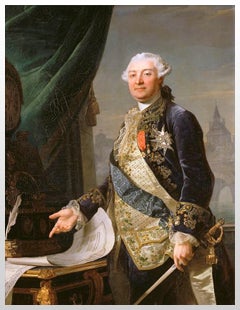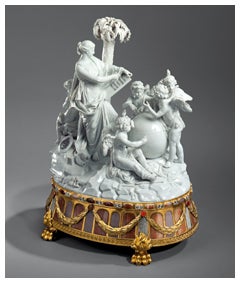A masterpiece by Johann-Christian Neuber (1736–1808), this small table is regarded as one of the most extraordinary examples of eighteenth-century furniture. It combines the scientific spirit of the Enlightenment, the refinement and technical perfection of the goldsmith’s art, and a prestigious history. Offered in 1781 by Friedrich Augustus III, Elector of Saxony (1750–1827), to Louis Auguste de Breteuil, Baron de Breteuil (1730–1807), in recognition for the role he played in the 1779 negotiation of the Treaty of Teschen, it is known today as the “Table of Peace,” the “Teschen Table,” the “Table of Europe,” or the “Breteuil Table.”
The history of the Breteuil Table is intimately linked to the French diplomat Baron de Breteuil, who was involved in secret diplomacy for several decades. While he was French ambassador in Vienna, Louis XVI asked him to represent France at the 1779 congress held in Teschen (a city now divided into towns in Poland and the Czech Republic).

Baron de Breteuil, Minister of the Royal Household for Louis XVI, François Louis Ménageot, oil on canvas, 1785.
Musée du Louvre, Paris.

Small monument commemorating the Treaty of Teschen
in embossed, gilt and varnished leather, with the portrait miniatures of the signatories.
Signed by JF Beer Francfort 1779. 36.3 cm high.
Musée du Louvre.
The subject of the Treaty of Teschen was the succession in Bavaria following the death of Maximilian III Joseph, who died without descendants on December 30, 1777. His legitimate heir was Charles Theodore of Sulzbach, Prince-Elector and Count Palatine, but other contenders for the succession soon appeared: the Elector of Saxony, Friedrich Augustus III; Joseph II, Emperor of the powerful Holy Roman Empire; his mother, Empress Maria-Theresa of Austria (also the mother of Marie-Antoinette); and Frederick II, King of Prussia. After months of fruitless negotiations, war between Austria and Prussia broke out in July 1778.
France and Russia offered their diplomatic services, and the two principal mediators met at Teschen: the Baron de Breteuil, representing France, and Prince Nikolai Wasilyevich Repnin (1732–1801), representing Russia. They were accompanied by representatives of each of the parties that were at war. After two months of negotiations, the Treaty of Teschen was signed on May 13, 1779, restoring peace in Europe. The Elector Palatine regained possession of the territories occupied by Austria while agreeing to give up part of Bavaria to Maria-Theresa of Austria. He also agreed to pay the Elector of Saxony six million guilders in compensation for his succession rights. Finally, the signatories promised to fight against any aggressor who would undermine the treaty. This principle of collective security would be the basis of the Covenant of the League of Nations and the Charter of the United Nations.
The main beneficiary of the peace treaty, the Elector of Saxony, offered the table by Neuber to the Baron de Breteuil. He gave a gift of equal value to Prince Repnin, a Meissen porcelain service of several hundred pieces and a large centerpiece composed of seven bases by Neuber, each supporting a porcelain allegorical group.
Famous during the nineteenth century, the Table de Breteuil appeared in Marcel Proust’s Swann’s Way in the residence of the Princess of Iéna: “I think they have very nice things, they must have the famous mosaic table on which was signed the Treaty.”
For the table’s design, Neuber employed the concept of his Steinkabinettabatiere (stone cabinet snuffbox) but enlarged the size of the stones nearly ten times. As he did with the boxes, he compiled a catalogue of the 128 stones he used for the top alone, beautifully handwritten by Carl Gottfried Nestler (1730–1780). The German historian Johann Georg Meusel noted this particularity in 1782: “a compartment under the tray keeps the record of all the stones used and the places where they were extracted and are to be found.” Thus, the table became an object of mineralogical interest. Considered a perfect reflection of the wealth and refinement of Saxony, it represented both the beauty of nature and the scientific spirit of the Enlightenment.
Still owned by the family that received it nearly 250 years ago, this table has rarely been exhibited outside the Château de Breteuil (some twenty-five miles west of Paris) and has never before crossed the Atlantic.

The History of Saxony, a group in Meissen porcelain by Michel Victor Acier made at the same time and from the same mold as the group presented by Friedrich Augustus III, Elector of Saxony, to Prince Repnin, 1779−80.
Staatliche Kunstsammlungen Dresden, Porzellansammlung.
It seats on a base in gilt bronze with Saxon gemstones by Johann Chritian Neuber made for the centerpiece presented by Friedrich Augustus III, Elector of Saxony, to Prince Repnin, 1779−80.
Private collection.

The Château de Breteuil